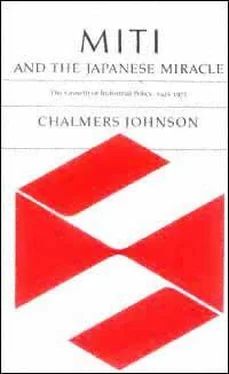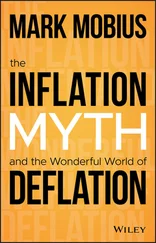Chalmers Johnson - MITI and the Japanese miracle
Здесь есть возможность читать онлайн «Chalmers Johnson - MITI and the Japanese miracle» весь текст электронной книги совершенно бесплатно (целиком полную версию без сокращений). В некоторых случаях можно слушать аудио, скачать через торрент в формате fb2 и присутствует краткое содержание. Год выпуска: 2007, Издательство: Stanford University Press, Жанр: Старинная литература, на английском языке. Описание произведения, (предисловие) а так же отзывы посетителей доступны на портале библиотеки ЛибКат.
- Название:MITI and the Japanese miracle
- Автор:
- Издательство:Stanford University Press
- Жанр:
- Год:2007
- ISBN:нет данных
- Рейтинг книги:3 / 5. Голосов: 1
-
Избранное:Добавить в избранное
- Отзывы:
-
Ваша оценка:
- 60
- 1
- 2
- 3
- 4
- 5
MITI and the Japanese miracle: краткое содержание, описание и аннотация
Предлагаем к чтению аннотацию, описание, краткое содержание или предисловие (зависит от того, что написал сам автор книги «MITI and the Japanese miracle»). Если вы не нашли необходимую информацию о книге — напишите в комментариях, мы постараемся отыскать её.
MITI and the Japanese miracle — читать онлайн бесплатно полную книгу (весь текст) целиком
Ниже представлен текст книги, разбитый по страницам. Система сохранения места последней прочитанной страницы, позволяет с удобством читать онлайн бесплатно книгу «MITI and the Japanese miracle», без необходимости каждый раз заново искать на чём Вы остановились. Поставьте закладку, и сможете в любой момент перейти на страницу, на которой закончили чтение.
Интервал:
Закладка:
Page 11
interacting freely with each other and unconstrained in any meaningful ways. It rejects as contrary to economic logic, and therefore as spurious, all the concepts that the Japanese have invented and employed continuously in discussing and managing their economysuch concepts as "industrial structure," "excessive competition," "coordination of investment," and ''public-private cooperation." Most seriously, from a historical point of view, this explanation short-circuits attempts to analyze what difference the government's intervention has actually made by declaring in advance and as a matter of principle that it made no difference. The result is, as John Roberts has put it, that Japan's " 'miraculous' emergence as a first-rate economic power in the 1960s has been described exhaustively by Japanese and foreign writers, and yet very little of the literature provides credible explanations of how it was done, or by whom."
20
This study is an attempt to answer these questions.
The third prevalent type of analysis of the Japanese miraclestressing the influence of unusual Japanese institutionsis by far the most important of the four I have isolated, and the one that has been most thoroughly discussed in Japan and abroad. In its simplest form it asserts that Japan obtained a special economic advantage because of what postwar Japanese employers habitually call their "three sacred treasures"the "lifetime" employment system, the seniority (
nenko
*) wage system, and enterprise unionism.
21
Amaya Naohiro of MITI, for example, cites these three institutions as the essence of what he terms Japan's
uchiwa
(all in the family) economic system; and in reporting to the Organization for Economic Cooperation and Development's Industry Committee during 1970, the former MITI vice-minister Ojimi* Yoshihisa referred to various "typically Japanese phenomena" that had helped Japan to obtain its high-speed growththe phenomena again being the three sacred treasures.
22
Because of these institutions, the argument goes, Japan obtains greater labor commitment, loses fewer days to strikes, can innovate more easily, has better quality control, and in general produces more of the right things sooner than its international competitors.
This argument is undoubtedly true, but it has never been clearly formulated and is, at best, simplistic. There are several points to be made. First, the three sacred treasures are not the only "special institutions," and they are certainly not the most sacred. Others include the personal savings system; the distribution system; the "descent from heaven" (
amakudari
) of retired bureaucrats from the ministries into senior management positions in private enterprises; the structure of industrial groupings (
keiretsu
, or the oligopolistic organization of
Page 12
each industry by conglomerates); the "dual economy" (what Clark usefully terms the system of "industrial gradation"
23
) together with the elaborate structure of subcontracting it generates; the tax system; the extremely low degree of influence exercised over companies by shareholders; the hundred-odd ''public policy companies" (public corporations of several different forms); and, perhaps most important of all, the government-controlled financial institutions, particularly the Japan Development Bank and the "second," or investment, budget (the Fiscal Investment and Loan Plan).
24
It is unnecessary here to describe each of these institutions. Most of them are quite familiar even to novice Japan watchers, and others will be analyzed in detail later in this book since they constitute some of the primary tools of the government for influencing and guiding the economy. What needs to be stressed is that they constitute a systemone that no individual or agency ever planned and one that has developed over time as ad hoc responses to, or unintended consequences of, Japan's late development and the progrowth policies of the government. Taken together as a system, they constitute a formidable set of institutions for promoting economic growth (a "GNP machine," in Amaya's metaphor), but taken separately, as they most commonly are, they do not make much sense at all.
25
And this is the primary reservation that one must make about the unique-institutions explanation: it never goes far enough and therefore fails as anything more than a partial explanation.
Let us take one example. As a result of the recognition of the Japanese miracle around the world, some American professors of business administration have begun to recommend to American entrepreneurs that they experiment with one or all of the three sacred treasures. Sometimes Japanese practices, suitably modified, travel well.
26
However, an American businessman who really attempted to institute "lifetime" employment without the backing of the other institutions of the Japanese system would soon find himself bankrupt. Among other things, lifetime employment in Japan is not for life but until the middle or late fifties; and although wage raises are tied to seniority, job security is not: it is those with most seniority who are the first fired during business downturns because they are the most expensive. Lifetime employment also does not apply to the "temporaries," who may spend their entire working lives in that status, and temporaries constitute a much larger proportion of a firm's work force than any American union would tolerate (42 percent of the Toyota Motor Company's work force during the 1960's, for example).
27
Even if these problems could be taken care of, the American em-
Page 13
ployer still would not have below him the extensive enterprise sector of medium and smaller subcontractors that his Japanese counterpart can squeeze in difficult times. Tomioka calls the subcontractors the "shock absorbers" of the Japanese business cyclethe smaller firms on the receiving end when large firms find they can no longer carry the fixed costs of their labor force and must "shift the strain" (
shiwayose
).
28
On the other hand, the American employee would not have Japan's extensive if redundant distribution system to fall back on in case he did get laid off. The distribution system in Japan serves as a vast sponge for the unemployed or underemployed when economic conditions require it. As testimony to the layers of middlemen in Japan, the volume of transactions among Japanese wholesalers in 1968 exceeded the total of retail sales by a ratio of 4.8 to 1, whereas the United States figure was 1.3 to 1.
29
It is not surprising that many knowledgeable Japanese do not want to change the distribution system, despite protests from foreign salesmen who have trouble breaking into it, because it performs other functions for the society than distribution, not the least of which is reducing the tax burden necessary to provide adequate unemployment insurance.
Lifetime employment, Japanese style, offers many advantages from the point of view of economic growth: it provides a strong incentive to the employer to operate at full or close to full capacity; it inhibits a horizontally structured trade union movement; and, in the words of Ohkawa and Rosovsky, it gives the Japanese entrepreneur "a labor force without incentives to oppose technological and organizational progress even of the labor-saving type."
30
But it does not exist in isolation and would not work without the rest of the system of "unique institutions."
The second main point about these special institutions concerns the date of their origins and how they are maintained. It is here that this school of explanations of the miracle sometimes blends imperceptibly with the first school, which says that Japanese culture and the Japanese national character support the economy. Amaya, for example, traces the three sacred treasures to the traditional world of family (
Читать дальшеИнтервал:
Закладка:
Похожие книги на «MITI and the Japanese miracle»
Представляем Вашему вниманию похожие книги на «MITI and the Japanese miracle» списком для выбора. Мы отобрали схожую по названию и смыслу литературу в надежде предоставить читателям больше вариантов отыскать новые, интересные, ещё непрочитанные произведения.
Обсуждение, отзывы о книге «MITI and the Japanese miracle» и просто собственные мнения читателей. Оставьте ваши комментарии, напишите, что Вы думаете о произведении, его смысле или главных героях. Укажите что конкретно понравилось, а что нет, и почему Вы так считаете.












